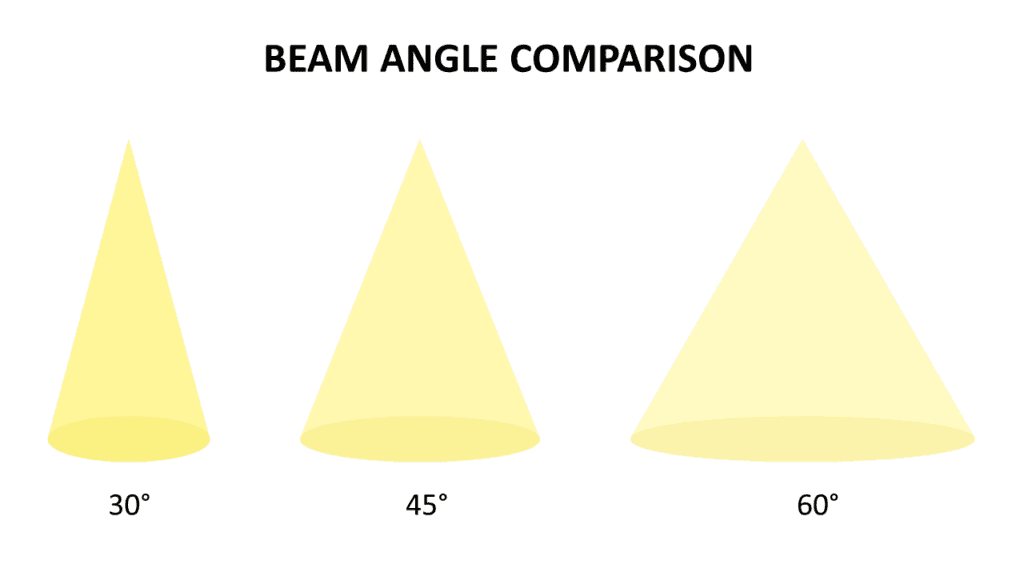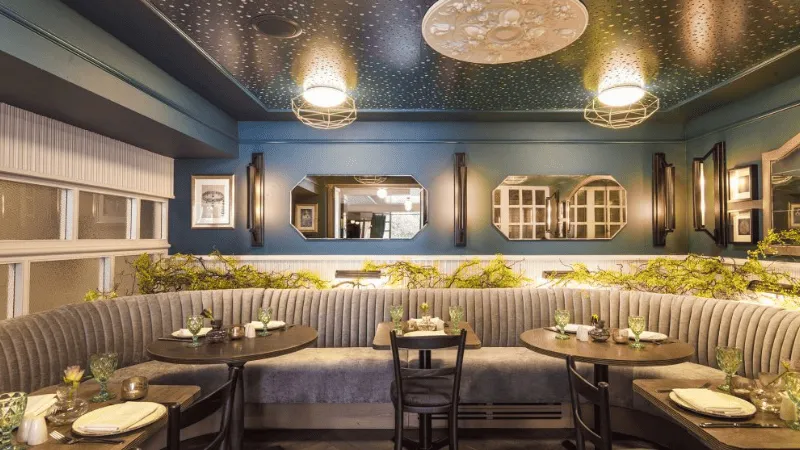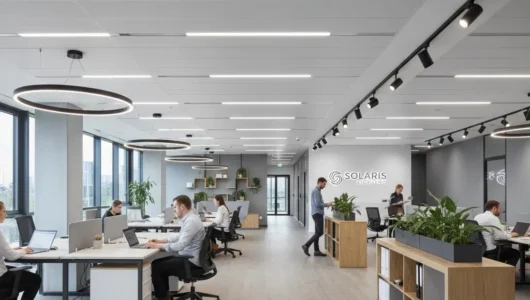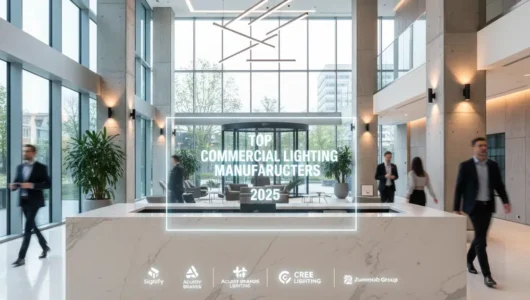L'angle de rayonnement est une mesure simple qui vous aide à optimiser la couverture lumineuse à l'intérieur de votre maison ou de votre bâtiment. Tout travail d'éclairage moderne implique le calcul de l'angle de rayonnement et de la diffusion de la lumière. L'angle de rayonnement est souvent utilisé dans les travaux d'éclairage, mais peu de gens en connaissent les détails et les utilisations.
Voici donc un guide détaillé pour vous aider à comprendre ce qu'est l'angle du faisceau en l'éclairage et choisissez l'angle de rayonnement idéal pour vos besoins.
Qu'est-ce que l'angle du faisceau ?
L'angle du faisceau mesure la dispersion de la lumière provenant d'une source lumineuse (telle qu'une ampoule). Plus l'angle du faisceau est grand, plus il y a de lumière dispersée, mais l'intensité de la lumière est également plus faible. Inversement, plus l'angle du faisceau est étroit, moins il y a de lumière dispersée, mais l'intensité de la lumière est plus élevée.

Cette intensité lumineuse est généralement mesurée en lumens. Les lumens par mètre carré sont appelés "lux"et les lumens par pied carré sont appelés "bougies de pied." Le nombre total de lumens nécessaires pour éclairer une pièce varie en fonction du type d'éclairage et de la taille de la pièce.
Exemples :
1. Que signifie un angle de faisceau de 120 ?
120 fait référence à l'angle du luminaire. Un angle de 120° est un angle de rayonnement large pour une ampoule qui peut couvrir une pièce entière si le plafond est suffisamment haut.
2. Que signifie l'angle de rayonnement étroit ?
L'angle de rayonnement étroit désigne les ampoules dont l'angle de rayonnement est inférieur à 30°. Il existe toutefois des catégories plus détaillées d'angle de rayonnement, telles que l'angle de spot ou l'angle de rayonnement plus étroit.
3. Angles communs des faisceaux
Il existe deux façons de désigner l'angle du faisceau. L'une utilise des degrés, tels que 10°, 60°, 120°, etc. L'autre utilise des termes tels que "angle de faisceau étroit", "angle de spot", "large", "angle plus large", etc.
Les termes et les normes relatifs à l'angle du faisceau ne sont pas universels, mais la classification NEMA est la plus couramment utilisée. La NEMA est la National Electrical Manufacturers Association, la plus grande association de fabricants d'équipements électriques.
| Angle du faisceau (°) | Type NEMA | Description |
|---|---|---|
| 10° - 18° | 1 | Très étroit |
| 18° - 29° | 2 | Étroite |
| 29° - 46° | 3 | Moyennement étroit |
| 46° - 70° | 4 | Moyen |
| 70° - 100° | 5 | Moyennement large |
| 100° - 130° | 6 | Large |
| 130° ou plus | 7 | Très large |
Pourquoi l'angle du faisceau est-il si important ?
L'angle du faisceau permet de déterminer la couverture lumineuse ; plus l'angle est grand, plus la couverture est importante, et vice versa. Pour couvrir entièrement le sol d'une pièce de 40×40 pieds carrés, il faut une lampe de 60° centrée sur un plafond de 34 pieds de haut, ou deux lampes de 60° situées à 10 pieds du centre d'un plafond de 17 pieds de haut.
Correct Le calcul de la répartition de la lumière permet d'obtenir un éclairage complet. en utilisant le moins d'appareils possible.
Les éclairages à faible angle de rayonnement ou à faisceau étroit peuvent également constituer un choix stylistique pour un éclairage d'accentuation ou d'ambiance.
Comment mesurer l'angle du faisceau ?
Voici une formule trigonométrique simple pour calculer l'angle du faisceau (propagation du faisceau).
Angle = 2* Tan-1 [Portée du faisceau / Distance lumineuse]

La dispersion du faisceau est ici de 50% de la puissance lumineuse totale ; toute lumière en dehors du centre concentré est appelée "lumière de débordement" ou "champ de faisceau".
L'angle de rayonnement d'une ampoule est calculé à l'aide d'instruments précis dans un environnement contrôlé. Le consommateur moyen n'a pas besoin de calculer l'angle ; il peut vérifier l'emballage de l'ampoule ou le site web du fabricant. Cette section n'a qu'un but informatif pour vous aider à mieux comprendre l'angle de rayonnement correct.
Critères de sélection de l'angle du faisceau
Maintenant que vous comprenez l'importance des poutres et la différence entre les angles de rayonnement étroits et larges, nous pouvons passer aux critères de sélection. Pour choisir le meilleur angle de poutre pour votre bâtiment, tenez compte de cinq facteurs.
1. Type de bâtiment
Il existe deux types de bâtiments principaux lorsque l'on considère l'angle de la poutre :
- Bâtiments résidentiels
- Bâtiments commerciaux
Les bâtiments résidentiels se concentrent sur l'uniformité l'éclairage dans chaque de la pièce. Par conséquent, un éclairage à grand angle au centre de la pièce est généralement suffisant.
En revanche, les bâtiments commerciaux tels que les restaurants ou les usines se concentrent sur l'éclairage efficace de grandes surfaces au sol. Ils ont besoin d'éclairages à angle moyen ou étroit répartis sur de grandes surfaces de plafond. Les restaurants se concentrent particulièrement sur l'éclairage d'ambiance et d'accentuation.
2. Luminaires
Luminaires sont le deuxième facteur le plus important dans le choix de l'angle du faisceau. Le luminaire est la base de la lampe, qui est généralement fixée au mur ou au plafond. Il peut également comporter une source lumineuse (ampoule ou LED).
Les luminaires peuvent modifier l'angle de rayonnement d'une ampoule. Les luminaires suspendus réduisent généralement l'angle, tandis que les luminaires encastrés peuvent l'augmenter.
3. Types d'éclairage
Le type d'éclairage peut varier en fonction de la personne à qui l'on s'adresse, mais traditionnellement, il existe trois types d'éclairage.
- Éclairage d'ambiance - L'éclairage diffus est utilisé pour éclairer l'ensemble d'une pièce.
- Éclairage d'accentuation - L'éclairage focalisé et indirect est généralement dirigé vers un mur.
- Éclairage de travail - Focalisé et direct l'éclairage met en valeur le travail comme les bureaux.
L'éclairage ambiant nécessite des angles de rayonnement larges, tandis que l'éclairage direct et l'éclairage d'accentuation requièrent des angles de lumière plus étroits.
4. Hauteur du plafond
Plus la source lumineuse est éloignée, plus l'intensité lumineuse est faible ; plus le plafond est haut, plus l'éclairage au niveau du sol est faible.
Les bâtiments résidentiels, tels que les maisons ou les appartements, ont des plafonds bas, généralement de 10 pieds ou moins. Par conséquent, ces bâtiments nécessitent des éclairages à grand angle pour couvrir l'ensemble de la pièce.
Les bâtiments commerciaux ou industriels, tels que les usines et les entrepôts, ont des plafonds hauts, généralement de plus de 25 pieds. Ces bâtiments nécessitent des angles de rayonnement puissants et étroits, ainsi que plusieurs luminaires pour couvrir l'ensemble de la zone.
5. Type d'ampoule
Nous avons déjà parlé des luminaires, mais les ampoules peuvent également varier considérablement. L'ampoule la plus courante que tout le monde connaît est l'ampoule de type A en forme de poire ; c'est l'ampoule qui apparaît au-dessus de votre tête lorsque vous avez une idée.

Les ampoules de type A n'ont pas de direction, c'est pourquoi nous plaçons des réflecteurs sur ces ampoules pour leur donner une direction. Les ampoules modernes, principalement les ampoules LED, s'allument PAR, BR, et Réflecteur MR les boyaux.
Quelle est la différence entre les ampoules de type PAR, BR et MR ?
- BR (Réflecteur convexe) = Angle de rayonnement > 90°.
- PAR (Parabolic Aluminized Reflector) = Angle de rayonnement > 45°.
- MR (Réflecteur multifacettes) = Angle de rayonnement 15° - 45
Quel angle de faisceau choisir ?
Enfin, nous avons couvert toutes les bases des angles de faisceau dans l'éclairage et nous pouvons maintenant commencer à faire des choix.
Le choix de l'angle du faisceau dépend de la application de l'éclairage. Les deux catégories les plus courantes de styles d'éclairage, et donc de choix d'angles de rayonnement, sont les bâtiments résidentiels et les bâtiments commerciaux.
1. Angles des poutres pour les bâtiments résidentiels
Comme nous l'avons déjà mentionné, les bâtiments résidentiels ont des plafonds plus bas et des surfaces plus petites. Nous pouvons utiliser le même angle de rayonnement pour les maisons et les appartements, car les deux sont très similaires du point de vue de l'éclairage.
Dans la plupart des maisons, un angle de rayonnement moyen (entre 40° et 60°) est suffisant pour éclairer une pièce. Toutefois, l'angle de rayonnement réel peut varier légèrement en fonction des cinq facteurs mentionnés ci-dessus.
Les salons sont plus grands que la plupart des autres pièces de la maison et comportent souvent une cuisine ou une salle à manger. Un angle de rayonnement plus large (supérieur à 60°) est recommandé pour couvrir le salon. Les salons n'ont pas non plus besoin d'autant de lumièreLe nombre d'appareils peut donc être réduit.

Vous devrez utiliser des angles d'éclairage plus étroits dans d'autres parties de la maison, comme les escaliers ou les garde-robes ; 25° est un angle standard pour des plafonds de 2,5 à 3,5 mètres.
Souvent, les maisons et les appartements utilisent une variété d'éclairages des styles. L'utilisation d'une variété d'appareils d'éclairage avec différents angles de rayonnement peut créer un attrait visuel. Le mélange et l'assortiment permettent également de créer des éclairages d'accentuation et des éclairages d'appoint.
2. Angles des poutres pour les bâtiments commerciaux
Les bâtiments commerciaux sont très différents des bâtiments résidentiels. En effet, il existe plusieurs types de bâtiments commerciaux. Par conséquent, pour faciliter la compréhension, nous avons réparti les bâtiments commerciaux dans les catégories suivantes.
Magasins de détail
Les magasins de détail ont un objectif en matière d'éclairageLes entreprises de l'Union européenne ont besoin de l'aide de l'Union européenne pour présenter leurs produits sous l'angle le plus flatteur possible. Une lumière idéale et flatteuse exige un minimum d'ombres et d'éblouissements. Pour cela, il faut un éclairage ambiant puissant qui couvre l'ensemble du magasin. Il est donc préférable d'utiliser des angles de rayonnement étroits et des ampoules multiples.
Par exemple, bijouteries utilisent des angles de rayonnement étroits, inférieurs à 10°, dans les vitrines. En revanche, l'éclairage des magasins de vêtements utilise des angles de rayonnement de 30° ou plus pour les mannequins.
Restaurants
Les restaurants sont une exception parmi les les espaces commerciaux parce qu'ils mettent l'accent sur l'esthétique et l'éclairage d'ambiance. De nombreux restaurants n'étant ouverts que le soir ou tard dans la nuit, ils évitent les environnements lumineux.
A éclairage standard des restaurants utilise un angle de rayonnement de 25° pour la table à manger.

Bureaux
Dans les bureaux, de nombreux employés sont répartis et un mauvais éclairage peut avoir pour effet d'éblouir certains employés alors que d'autres sont confinés dans l'ombre. En outre, les employés travail devant un écran d'ordinateur peuvent ressentir une fatigue oculaire si la lumière ambiante est trop faible.
Par conséquent, les bureaux sont mieux desservis par un angle de rayonnement large, généralement d'environ 60°, les angles de rayonnement plus étroits n'étant utilisés que pour l'éclairage des tâches.
Entrepôts
Les entrepôts ayant des plafonds élevés, des angles de faisceau plus étroits sont nécessaires pour maintenir leur intensité lorsqu'ils atteignent le sol. Les chiffres exacts varient en fonction de la hauteur du plafond.
Exemples pratiques d'angles de rayonnement
Le tableau ci-dessous décrit des scénarios pratiques appropriés pour différents angles de faisceau.
| Angle du faisceau | Bâtiment résidentiel | Bâtiment commercial |
|---|---|---|
| Étroite | Petites cuisinesCases d'escalierCommodes | Warehouses Accent light for Merchandise Restaurant Tables |
| Moyen | Salle à mangerSalles de séjour | Magasins de vêtements Éclairage général d'ambiance |
| Large | Éclairage extérieurGrandes pièces | Éclairage d'ambiance |
| Très large | Pièces à plafond basEclairage d'inondation | Lampes de rue |
Conclusion
Il s'agit d'un guide complet et détaillé sur les angles des faisceaux d'éclairage. Nous espérons que cet article vous permettra de comprendre les principes de base et d'utiliser les informations qu'il contient pour choisir l'éclairage de votre bâtiment.
L'angle de rayonnement peut être une mesure intimidante, mais une fois que vous l'avez comprise, il s'agit d'un concept simple. Utilisez un angle de faisceau large lorsque vous avez besoin d'un espace bien éclairé, et un angle de faisceau étroit lorsque vous avez besoin de mettre l'accent sur une zone. Bien entendu, n'hésitez pas à utiliser une combinaison d'angles de rayonnement pour obtenir votre environnement lumineux idéal.
Toutefois, si le processus de sélection de l'angle du faisceau vous semble trop fastidieux, vous pouvez compter sur les experts de RC Éclairage pour guider vous. Nous proposons une large gamme de produits d'intérieur et d'extérieur solutions d'éclairage pour les bâtiments résidentiels et commerciaux.
Vous n'avez pas d'adresse électronique professionnelle ? Cliquez ici !
Table des matières
Vous n'avez pas d'adresse électronique professionnelle ? Cliquez ici !




